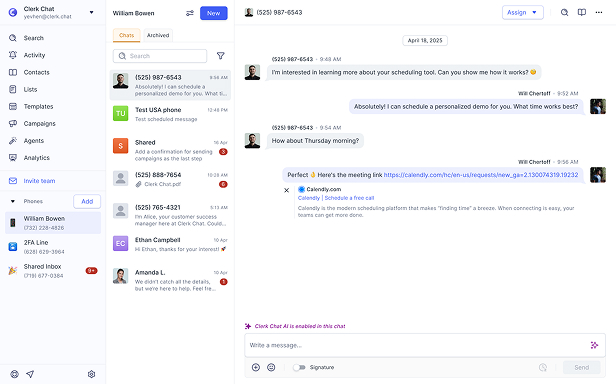What Works and What’s Next for Nonprofit Communications
By Alexander Haque
- Published: July 30, 2025
Key points in this article:
- Nonprofit communications encompasses everything from storytelling and engagement, to marketing and fundraiser communications, driving brand awareness, increased retention, and organization growth.
- Building a strong nonprofit communication strategy requires a focus on goal setting, identifying target audiences, choosing the right communication channels, and building a compelling messaging strategy.
- Best practices for nonprofit communications include investing in compliance, leveraging the right technology, and maintaining consistency.
- Emerging trends, such as omnichannel messaging, hyper-personalization, and AI and automation tools will have a significant impact on nonprofit communication efforts in the years ahead.
Think that optimizing your approach to nonprofit communications is just about investing in the right texting service for nonprofits or branching into new social media channels? Think again.
Ultimately, the success of any nonprofit organization depends on how well it can forge relationships with its backers, maintain engagement, and inspire action. That means you need a comprehensive nonprofit communication strategy focused on building trust.
The more effectively you connect with your supporters—whether through regular two-way SMS conversations, consistent updates, or inspirational content—the more you’ll be able to attract donations, volunteers, and growth opportunities.
So, how exactly do you build a communication strategy that drives results? Here’s everything you need to know about mastering the art of nonprofit communications.
In this article:
Understanding Nonprofit Communications
The term “nonprofit communications” refers to any type of communication between a nonprofit organization and its audience. This includes everything from nonprofit marketing campaigns across various digital and traditional channels to general thank-you messages sent to donors.
Struggling to connect with your supporter community?
Try Clerk ChatThere are three main types of nonprofit communications that most organizations focus on:
Storytelling and Ongoing Engagement
Storytelling connects community members to your cause through emotive, engaging, and informative content. For instance, you might use a mass text messaging service to inform backers about recent goals you’ve accomplished or share messages and stories from the people and communities you’ve helped.
Alternatively, you could use various channels, from your website to social media platforms and even email services, to keep backers connected to your story. For example, a university could share quotes and stories from current students and alumni about the challenges they’ve overcome in the academic world. An animal shelter might share stories about people who adopted pets from their organization or animals that overcame hardships.
Storytelling helps keep your audience emotionally engaged and invested in your work while supporting your organization’s credibility.
Nonprofit Marketing Communications
While nonprofit communications focused on storytelling help boost brand awareness and maintain engagement among existing donors, marketing communications are designed to motivate people to take action.
Depending on your goals, your marketing strategy might focus on prompting backers to:
- Make a donation
- Volunteer for an upcoming fundraiser
- Purchase branded merchandise
- Become a monthly donor
- Sign up for a newsletter or SMS broadcast service
- Register for an event
Like marketing messages used by for-profit companies, nonprofit marketing communications should highlight your value proposition, mission, and the benefits of supporting your cause. They should also be personalized to appeal to specific groups of supporters. For instance, an educational institution using school communication apps might segment its audience based on their previous involvement in fundraising activities or the age of their children.
Fundraising Nonprofit Communications
Communication strategies for nonprofits focused on fundraising are similar to marketing strategies but concentrate on a single specific goal: raising donations.
This form of communication is complicated because nonprofits must cater to various audiences. For instance, you might need to create a strategy for communicating with current donors, thanking them for their support and encouraging continued donations. You’ll also need to consider potential backers, volunteers who might contribute to future events, corporations or institutions that might contribute to your cause, and more.
Often, the key to success with these communications is a focus on personalization and simplicity. Adapt your messages to the interests and goals of each audience group and make it simple for them to support you with features like “text to donate.”
Nonprofit Communications vs. Marketing, Fundraising, and Storytelling
Marketing, fundraising, and storytelling are all core components of a holistic communications strategy for nonprofits. However, each type of communication serves a different purpose. Overall, nonprofit communications can serve various purposes, including building awareness of your cause, boosting donor engagement through storytelling, driving stakeholders to take action through marketing messages, and generating financial support through fundraising communications.
Additionally, strategic communications for nonprofit organizations can assist with tasks and challenges like:
- Managing your reputation (addressing stakeholder concerns)
- Human resources (keeping teams connected and informed)
- Disseminating crucial information (emergency alerts and updates)
Your nonprofit communication strategy should cover every form and type of communication relevant to your growing brand.
How to Build Communication Strategies for Nonprofits
Creating an effective nonprofit communications strategy involves several steps. Here’s how you can get started:
Step 1: Define Communication Goals
First, decide what you want to accomplish with your nonprofit communications strategy. Potential objectives include:
- Earning Donations: Fundraising is key to powering a sustainable nonprofit. Consider scheduling message campaigns to reach audience members at specific times, thanking them for their previous contributions and encouraging continued financial support.
- Recruiting Volunteers: Dedicated volunteers can be as valuable as donations. Your strategy could focus on encouraging volunteers to support your cause during future events or asking existing volunteers to invite new backers.
- Spreading Awareness: Sharing stories about your cause can attract more donors and volunteers. Use your communication strategy to share insights across channels, from your website to social media platforms and industry publications.
Identifying your specific goals early will help determine the kind of messages you need to create and which channels to use.
Step 2: Identify Your Target Audience(s)
Once you’ve determined your objectives, figure out who you’re trying to reach. Typical target audiences for nonprofit organizations include:
- Donors: Backers who support your organization with financial contributions.
- Volunteers: Community members who help organize fundraising efforts, run events, sell products, or connect with other supporters.
- Potential Supporters: Individuals interested in supporting your cause.
- Internal Team Members: Employees and board members who actively contribute to shaping the future of your nonprofit organization.
- The General Public: People who might want to learn about your activities and help raise public awareness about an issue.
Defining your target audience is crucial for customizing messages, campaigns, and content to appeal to specific groups.
Step 3: Identify Communication Channels
Effective nonprofit communications often rely on a wide range of channels. Different communication methods suit different goals and audiences. For raising awareness among new supporters, use public and accessible channels like television ads, radio campaigns, social media strategies, and blog posts or press releases. For existing community members, direct channels like SMS, email, or phone calls can be more effective.


Step 4: Create a Clear Messaging Strategy
Develop a messaging strategy that is consistent across all platforms. Every message should highlight your nonprofit’s purpose, mission, values, unique personality, reasons for supporting your cause, the impact of supporters, and what makes your organization unique. Tailor your messaging to the channel you’re using, keeping it clear and easy to understand.
Step 5: Measure the Results of Every Strategy
Gather insights from every facet of your communication strategy. Metrics on engagement, open rates, and click-through rates can help you build more effective strategies, schedule messages strategically, and identify what types of content appeal most to different audience segments.
Struggling to connect with your supporter community?
Try Clerk ChatNonprofit Communications Best Practices
Before diving into your nonprofit communications strategy, consider these additional tips and best practices:
Remember Compliance
Ensure you adhere to communication laws, including managing SMS opt-ins and opt-outs, getting permission for direct communications, and familiarizing yourself with the rules and algorithms on social media channels.
Use Tools and Technology to Your Advantage
Leverage technology to manage various communication campaigns. Platforms like an SMS customer service platform can help align your volunteers and answer supporter questions. Conversational AI platforms can support, inform, and inspire your employees, volunteers, and backers 24/7 across multiple channels and languages.
Be Consistent and Audience-Focused
Consistency is crucial in nonprofit communications. Continuously showcase your mission, vision, and values to your audience, adapting your communication strategies to their priorities. Keep your community engaged and informed to maintain strong relationships and foster growth.
Trends Shaping Communications for Nonprofits
The landscape of nonprofit communications is constantly evolving. Recent trends include:
- Omnichannel Communication: Nonprofits are embracing various channels, from social media platforms to SMS, RCS, blogs, podcasts, and direct phone calls, to meet supporters where they are.
- Hyper-Personalization: Personalized communication strategies lead to higher open rates, increased donor retention, and a stronger return on marketing investment.
- AI and Automation: Nonprofits are using AI and automation to improve customer service, manage donor inquiries, streamline the donation process, personalize marketing campaigns, and automate repetitive tasks.
Nonprofits are also becoming more experimental, investing in hybrid and virtual event experiences, social fundraising drives, micro-donation opportunities, and loyalty programs tailored to supporter needs.
Stay ahead by maintaining curiosity, exploring new tools and technologies, sourcing insights and feedback from your community, and learning from successful campaigns and strategies of other organizations.
Upgrade Nonprofit Communications with Clerk Chat
Mastering nonprofit communications can be complex, but a well-crafted strategy can significantly benefit your cause. Platforms like Clerk Chat make it easy to revolutionize communications with supporters, board members, and volunteers alike.
Clerk Chat combines a comprehensive charity texting service with conversational AI tools, powerful templates, in-depth analytics, and omnichannel integrations. Whether you’re looking to boost donor engagement, earn more financial support, or align and inspire your volunteers, Clerk Chat is here to help.
Dive into a new era of effective nonprofit communications today with Clerk Chat.
Alex is passionate about building truly groundbreaking technology that serves humanity. He strives to encourage work environments where teams show up authentically and are empowered to contribute their best work. Before Clerk Chat, Alex built, scaled, and sold Retinad VR, followed by working in partnerships and innovation at Samsung and Netflix, helping enable large-scale projects and products. In his free time you can find him gravel biking and reading philosophy.
In this article:
Ready to use your business number for text messaging?
Thousands of businesses are already experiencing the power of conversational messaging through SMS. Join us. Free trial and paid tiers available.
Get Started#Subscribe
Get product updates in your inbox
Tutorials, features, and Clerk Chat news delivered straight to you.




